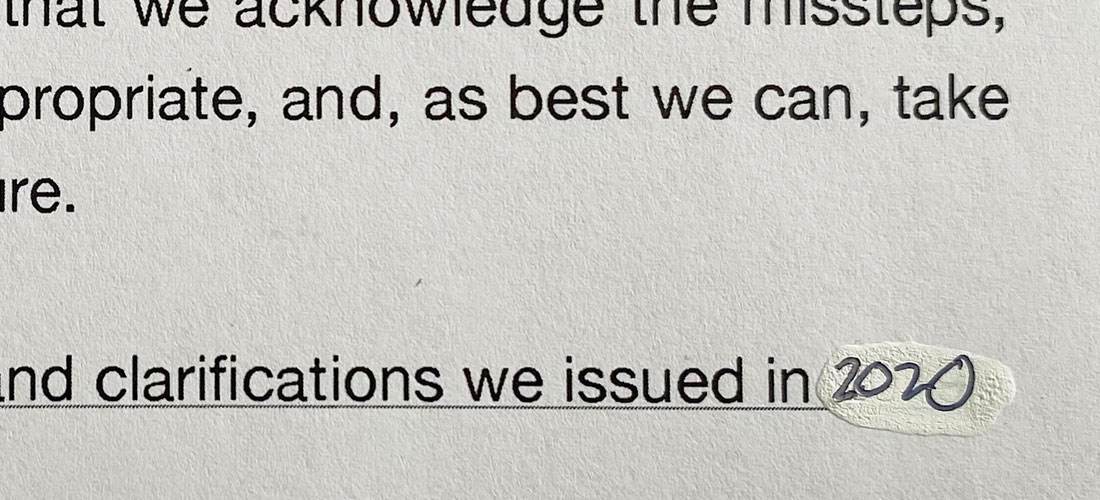Corrections And Clarifications: A Guide To Accurate Information

Table of Contents
Identifying the Need for Corrections and Clarifications
Swift and effective responses to errors are crucial for managing your organization's reputation and maintaining credibility. Knowing when a correction or clarification is needed is the first step in this process.
Recognizing Errors
Errors come in various forms, and prompt identification is key. These include:
- Factual Inaccuracies: Presenting incorrect data, statistics, or details. For example, misreporting a company's revenue figures or incorrectly stating a historical event.
- Misleading Statements: Information presented in a way that creates a false impression, even if technically not factually incorrect. This could involve using ambiguous language or omitting crucial context.
- Outdated Information: Publishing data or facts that are no longer current or relevant, leading to misinterpretations. For example, citing an old statistic without noting its age.
Timely responses are paramount. Delaying a correction only amplifies the damage and erodes trust.
Assessing the Impact
Determining the severity of an error requires careful consideration of its potential consequences. Ask yourself:
- Who was affected by the inaccurate information? Was it a small group, a wider audience, or the general public?
- What is the potential harm? Could it lead to financial loss, reputational damage, legal action, or even endanger public safety?
Thorough audience analysis is critical. Understanding your audience and the potential impact on them allows you to tailor your corrections and clarifications appropriately.
Crafting Effective Corrections and Clarifications
Once you've identified an error and assessed its impact, crafting a clear and concise correction is vital.
Writing Style and Tone
Clarity and conciseness are paramount. Use:
- Active voice: This makes your writing more direct and easier to understand.
- Strong verbs: These make your sentences more impactful and leave no room for misinterpretation.
Acknowledge the mistake without making excuses. A professional and straightforward tone fosters trust and demonstrates responsibility.
Choosing the Right Platform
The platform for your correction should match the visibility of the original error.
- Original Publication: If the error appeared in a newspaper, journal, or website, correcting it in the same place is essential.
- Social Media: If the error was shared on social media, a correction should be posted on the same platform.
- Website: A dedicated "Corrections" page on your website can be helpful for archiving corrections and demonstrating a commitment to accuracy.
Ensure the correction is easily visible and readily accessible to those who encountered the original mistake.
Legal Considerations
Inaccurate information can have serious legal ramifications.
- Defamation: Publishing false statements that harm someone's reputation.
- Libel: Written defamation.
If you are unsure about the legal implications of a correction, seek legal counsel.
Best Practices for Preventing Future Errors
Proactive measures are crucial to minimizing the need for corrections and clarifications.
Fact-Checking Procedures
Implement a robust fact-checking process:
- Use multiple sources to verify information.
- Cross-reference data and ensure consistency.
- Utilize fact-checking tools and resources available online.
Editorial Review and Approval
A multi-stage review process involving multiple editors can significantly reduce errors:
- Assign fact-checking responsibilities to different team members.
- Create a clear editorial workflow with defined stages of review and approval.
Training and Education
Regular training is essential:
- Conduct regular refresher training on fact-checking best practices, source verification, and ethical considerations in information dissemination.
- Educate staff on the importance of accuracy and the potential consequences of errors.
Conclusion: Mastering Corrections and Clarifications for Accurate Information
Timely and accurate corrections and clarifications are crucial for maintaining credibility and trust. Proactive measures to prevent errors, such as robust fact-checking and editorial review, are just as vital as the process of issuing corrections. By implementing these strategies for corrections and clarifications, you can build a reputation for accuracy and trust, improving your accurate information management and overall success.

Featured Posts
-
 Channing Tatum And Inka Williams A New Couple Spotted In West Hollywood
Apr 30, 2025
Channing Tatum And Inka Williams A New Couple Spotted In West Hollywood
Apr 30, 2025 -
 Chto Proizoshlo Na Superboule 2025 Dzhey Zi Teylor Svift Serena Uilyams I Drugie
Apr 30, 2025
Chto Proizoshlo Na Superboule 2025 Dzhey Zi Teylor Svift Serena Uilyams I Drugie
Apr 30, 2025 -
 State Of Emergency In Louisville Severe Weather Tornado And Flooding
Apr 30, 2025
State Of Emergency In Louisville Severe Weather Tornado And Flooding
Apr 30, 2025 -
 Hanh Trinh Xay Dung Mach 3 Du An 500k V Cong Nhan Dien Luc Mien Nam
Apr 30, 2025
Hanh Trinh Xay Dung Mach 3 Du An 500k V Cong Nhan Dien Luc Mien Nam
Apr 30, 2025 -
 Acquire The Charlotte Old Lantern Barn A Farmers And Foragers Legacy
Apr 30, 2025
Acquire The Charlotte Old Lantern Barn A Farmers And Foragers Legacy
Apr 30, 2025
